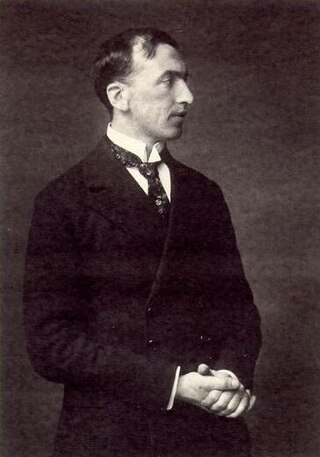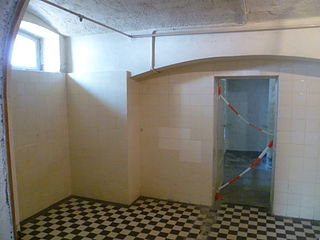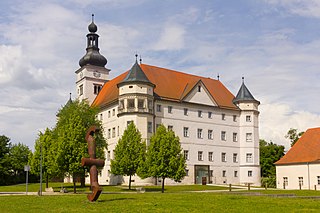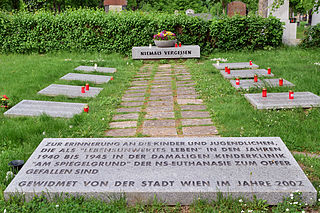Euthanasia is the practice of intentionally ending life to eliminate pain and suffering.

Hans Gerhard Creutzfeldt was a German neurologist and neuropathologist. Although he is typically credited as the physician to first describe the Creutzfeldt–Jakob disease, this has been disputed. He was born in Harburg an der Elbe and died in Munich.

Aktion T4 was a campaign of mass murder by involuntary euthanasia in Nazi Germany. The term was first used in post-war trials against doctors who had been involved in the killings. The name T4 is an abbreviation of Tiergartenstraße 4, a street address of the Chancellery department set up in early 1940, in the Berlin borough of Tiergarten, which recruited and paid personnel associated with Aktion T4. Certain German physicians were authorised to select patients "deemed incurably sick, after most critical medical examination" and then administer to them a "mercy death". In October 1939, Adolf Hitler signed a "euthanasia note", backdated to 1 September 1939, which authorised his physician Karl Brandt and Reichsleiter Philipp Bouhler to begin the killing.

Assisted suicide – sometimes referred to as medical aid in dying – means a procedure in which people take medications to end their own lives with the help of others, usually medical professionals. The term usually refers to physician-assisted suicide (PAS), which is an end of life measure for a person suffering a painful, terminal illness. Once it is determined that the person's situation qualifies under the physician-assisted suicide laws for that location, the physician's assistance is usually limited to writing a prescription for a lethal dose of drugs.

Viktor Hermann Brack was a member of the Schutzstaffel (SS) and a convicted Nazi war criminal and one of the prominent organisers of the involuntary euthanasia programme Aktion T4; this Nazi initiative resulted in the systematic murder of 275,000 to 300,000 disabled people. He held various positions of responsibility in Hitler's Chancellery in Berlin. Following his role in the T4 programme, Brack was one of the men identified as responsible for the gassing of Jews in extermination camps, having conferred with Odilo Globočnik about its use in the practical implementation of the Final Solution. Brack was sentenced to death in 1947 in the Doctors' Trial and executed by hanging in 1948.

The phrase "life unworthy of life" was a Nazi designation for the segments of the populace which, according to the Nazi regime, had no right to live. Those individuals were targeted to be murdered by the state ("euthanized"), usually through the compulsion or deception of their caretakers. The term included people with serious medical problems and those considered grossly inferior according to the racial policy of Nazi Germany. This concept formed an important component of the ideology of Nazism and eventually helped lead to the Holocaust. It is similar to but more restrictive than the concept of Untermensch, subhumans, as not all "subhumans" were considered unworthy of life.
Voluntary euthanasia is the ending of a person's life at their request in order to relieve them of suffering. Voluntary euthanasia and physician-assisted suicide (PAS) have been the focus of intense debate in recent years. Some forms of voluntary euthanasia are legal in Australia, Belgium, Canada, Colombia, Luxembourg, the Netherlands, New Zealand, and Spain.

The Hadamar killing centre was a killing facility involved in the Nazi involuntary euthanasia programme known as Aktion T4. It was housed within a psychiatric hospital located in the German town of Hadamar, near Limburg in Hessen.
Involuntary treatment refers to medical treatment undertaken without the consent of the person being treated. Involuntary treatment is permitted by law in some countries when overseen by the judiciary through court orders; other countries defer directly to the medical opinions of doctors.

Schloss Hartheim, also known as Hartheim Castle, is a castle at Alkoven in Upper Austria, some 14 kilometres (9 mi) from Linz, Austria. It was built by Jakob von Aspen in 1600, and it is a prominent Renaissance castle in the country.

Am Spiegelgrund was a children's clinic in Vienna during World War II, where 789 patients were murdered under child euthanasia in Nazi Germany. Between 1940 and 1945, the clinic operated as part of the psychiatric hospital Am Steinhof later known as the Otto Wagner Clinic within the Baumgartner Medical Center located in Penzing, the 14th district of Vienna.

The social policies of eugenics in Nazi Germany were composed of various ideas about genetics. The racial ideology of Nazism placed the biological improvement of the German people by selective breeding of "Nordic" or "Aryan" traits at its center. These policies were used to justify the involuntary sterilization and mass-murder of those deemed "undesirable".

The Grafeneck Euthanasia Centre housed in Grafeneck Castle was one of Nazi Germany's killing centres as part of their forced euthanasia programme. Today, it is a memorial site dedicated to the victims of the state-authorised programme also referred to since as Action T4. At least 10,500 mentally and physically disabled people, predominantly from Bavaria and Baden-Württemberg, were systematically killed during 1940. It was one of the first places in Nazi Germany where people were killed in large numbers in a gas chamber using carbon monoxide. This was the beginning of the Euthanasia Programme. Grafeneck was also the central office of the "Charitable Ambulance Transport GmbH" (Gekrat), which was headed by Reinhold Vorberg and responsible for the transport of T4.
Non-voluntary euthanasia is euthanasia conducted when the explicit consent of the individual concerned is unavailable, such as when the person is in a persistent vegetative state, or in the case of young children. It contrasts with involuntary euthanasia, when euthanasia is performed against the will of the patient.

Euthanasia in Canada in its legal voluntary form is called Medical Assistance in Dying and it first became legal along with assisted suicide in June 2016 for those whose death was reasonably foreseeable. In March 2021, the law was further amended by Bill C-7 which to include those suffering from a grievous and irremediable condition whose death was not reasonably foreseeable. According to the Fourth Annual Report on MAID, there were 13,241 MAID deaths reported in Canada in 2022.

Action 14f13, also called Sonderbehandlung14f13 and Aktion 14f13, was a campaign by Nazi Germany to murder Nazi concentration camp prisoners. As part of the campaign, also called invalid or prisoner euthanasia, the sick, the elderly and those prisoners who were no longer deemed fit for work were separated from the rest of the prisoners during a selection process, after which they were murdered. The Nazi campaign was in operation from 1941 to 1944 and later covered other groups of concentration camp prisoners.
Critics of euthanasia sometimes claim that legalizing any form of the practice will lead to a slippery slope effect, resulting eventually in non-voluntary or even involuntary euthanasia. The slippery slope argument has been present in the euthanasia debate since at least the 1930s.

The Sonnenstein Euthanasia Clinic was a Nazi killing centre located in the former fortress of Sonnenstein Castle near Pirna in eastern Germany, where a hospital had been established in 1811.

The Memorial and Information Point for the Victims of National Socialist Euthanasia Killings is a memorial in Berlin, Germany to the victims of Nazi Germany's state-sponsored involuntarily euthanasia program. Over 70,000 people were murdered between 1940–41 under official order of Aktion T4. Despite the program's technical cessation in August 1941, the killings continued in state-run institutions and care facilities until Germany's surrender in 1945. This amounted to a death toll of approximately 300,000.
Adolf Hitler signed a memorandum authorizing involuntary euthanasia in October 1939 to serve as the legal basis for Aktion T4, the Nazi involuntary euthanasia program. Its purpose was to assure the doctors and nurses who took part in the 'euthanasia' program would not be prosecuted for murder. During the postwar trials of these same individuals, they attempted to use this decree as a justification for their actions. An estimated 200,000 people were murdered under Aktion T4.














